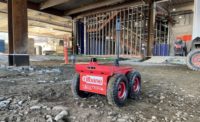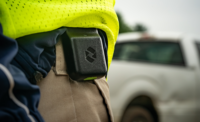On a sunny day late last December on the track of the Homestead Miami Speedway in Florida, humanoid robots representing 16 teams from around the world opened doors, turned valves, cut through walls, struggled to climb ladders and drove all-terrain vehicles. The competition was only the first set of trials in the Defense Advanced Research Projects Agency's "Robotics Challenge." DARPA is exploring how engineers can apply the repetitive and algorithm-driven advantages of modern robotics to the varied and often unpredictable environments of disaster zones and, by extension, real-world working situations, such as construction jobsites.
DARPA, a division of the U.S. Dept. of Defense, focused on funding the development of emerging technologies, announced the challenge after the March 2011 disaster at the Fukushima Daiichi nuclear powerplant in Japan. The devastation wrought by the tsunami and the plant's ensuing radiation leaks hampered response and containment efforts. DARPA's trials are designed around the tasks a human might have to perform in a similar disaster-response scenario.
Robots are found, traditionally, in highly controlled environments, such as factories and manufacturing facilities, in which infrastructure is designed to their benefit. But recent advances in both lightweight-but-powerful machinery and sophisticated control software are allowing robots to venture into previously uncharted territory, such as construction.
Still, spectators at the event who had hopes that robots are ready to replace some human workers likely saw their expectations dashed with the machines: Only some of the robots made real progress on the tasks. The highest-scoring entrant, a robot from the Japan-based SCHAFT team (far right, bottom), managed 27 out of the 32 points awarded in the tests. Some of the other teams looked at DARPA's short, one-year lead time for the contest and chose to focus on a robot for specific tasks, rather than a jack-of-all-trades robot. "It was a very ambitious goal to design and build a fully functional robot in less than a year, and that's what we did," said Steve DiAntonio, business development director at the National Robotics Engineering Center at Carnegie Mellon University. CMU's Tartan Rescue team designed its robot, Chimp (far right, top), around completing the tasks that require complex, hand-like manipulation, rather than ones that called for mobility. Since Chimp came in fourth place overall, with 18 out 32 points, it will move on to the next set of trials.
The top-scoring teams from the December competition are currently at work improving their creations for the next round of trials, likely in December or in early 2015. "We're expecting the finals to be a big deal," says DiAntonio. "This is ground-breaking, radical new technology." While some teams elected to use the Atlas humanoid robot from Google-owned Boston Dynamics as their hardware base, CMU chose to design its own robot using custom parts. "We chose to go with electrically driven motors—they're better for fine manipulations," says DiAntonio. "There's not a lot of effective solutions on the market yet for mobile manipulation tasks, so much of Chimp is custom-designed to get the necessary strength in the joints."
CMU was also one of the teams involved in an earlier DARPA challenge to develop self-driving cars. Technology prototypes based on early trials are now being pilot-tested on actual roads. "The difference with that competition was that, by the third round, the automotive companies were involved," says DiAntonio. "GM was our largest sponsor, and Ford and Toyota were involved, as well. They all saw where this was heading." So far, firms involved in disaster response and construction have not stepped up to sponsor CMU's team, but DiAntonio expects the improved robots at the next trials to draw their interest.
Construction sites today are not particularly robot-friendly, but the growing use of prefabricated components can move the more repetitive tasks off-site to the controlled factory environment in which robots really shine. "As a robotics group, we would prefer for the infrastructure to be designed for a robotics environment," says DiAntonio. "Construction is chaotic. But if people see the value of robots, then, maybe over the next few years, you could add more infrastructure to make sites more friendly for automation."
In DiAntonio's vision—fully autonomous jobsites in which robots of all shapes and sizes scurry about with minimal or even nonexistent human intervention—may still be a ways off. "I tried to break into construction, but that's a tough one," he says. "There's a small company up near Rochester [N.Y.] with a bricklaying robot. That's an interesting one. Go and find a task that lends itself to a robot solution: very geometric, repeatable work."
Increasing Productivity, One Brick at a Time
On a jobsite in upstate New York, a semi-autonomous mason machine, or SAM, selects bricks and then mortars and sets them in place until a wall takes shape. Consisting of a robotic arm and chassis, SAM looks as if it were plucked off a factory assembly line. Once its tasks are completed, SAM waits for its human operator to move it up the scaffolding masts to the next work area. Developed by Victor, N.Y.-based Construction Robotics, SAM is currently in beta testing and slated to be commercially available in 2015. (SAM's components are made by Stäubli, a Swiss-based manufacturer of industrial robots).
"At a full sprint, SAM can lay bricks at speeds comparable to a mason," says Scott Peters, vice president at Construction Robotics. "But there's the issue of worker fatigue—they take breaks. So, in a day, a mason can do about 400 to 500 bricks. But now you can have the mason minding the machine, and it can do 1,400 to 1,500 bricks a day."
SAM performs its masonry tasks based on "recipes," CAD drawings loaded into its memory prior to the start of work. Laser sensors placed along the wall allow SAM to "see" the wall plane and coordinate its actions. "What you design in CAD, you can put in the unit," says Peters. "You'll have the laser string poles move up and down the wall, with self-aligning lasers to define the wall plane. Once you get SAM up there, the operator will turn it on, and it will see the lasers and know where the wall is." The operator can interact with SAM via a tablet interface, with a continuously updating 3D CAD model as each brick is placed. If drawings don't match the site, SAM's software can recalculate the necessary mortar gap between the bricks and adjust accordingly.
Peters says masons testing SAM found it could fit into their normal workflow. "We were sitting there with the masons as they reacted to [SAM], and they first saw it as replacing people on their crew. We raised the idea of it just augmenting their crew," he says. "It's about finding a good balance, getting the crew off the jobsite sooner and putting workers to their best use."
SAM's mobility is currently a bit limited. At roughly 1,500 lb, the robot needs to be lifted into place by a forklift; it is then attached to a mast-climbing rail system. "We don't want to add a whole new scaffolding just for SAM," says Zak Podkaminer, marketing manager with Construction Robotics. "We're using the Hydro Mobile system, since that's the scaffolding we're seeing masons use on the jobsite. SAM's rail system attaches directly to the Hydro Mobile system, and the robot is able to move along those rails."
"The first release of SAM will be predominantly used for larger commercial projects: hospitals, schools, warehouses, offices. There, you have a lot of brick wall, and SAM can just go," says Peters. The final price of SAM hasn't been decided yet, but Peters expects masonry contractors could see a payback on their investment in SAM within three years.















Post a comment to this article
Report Abusive Comment